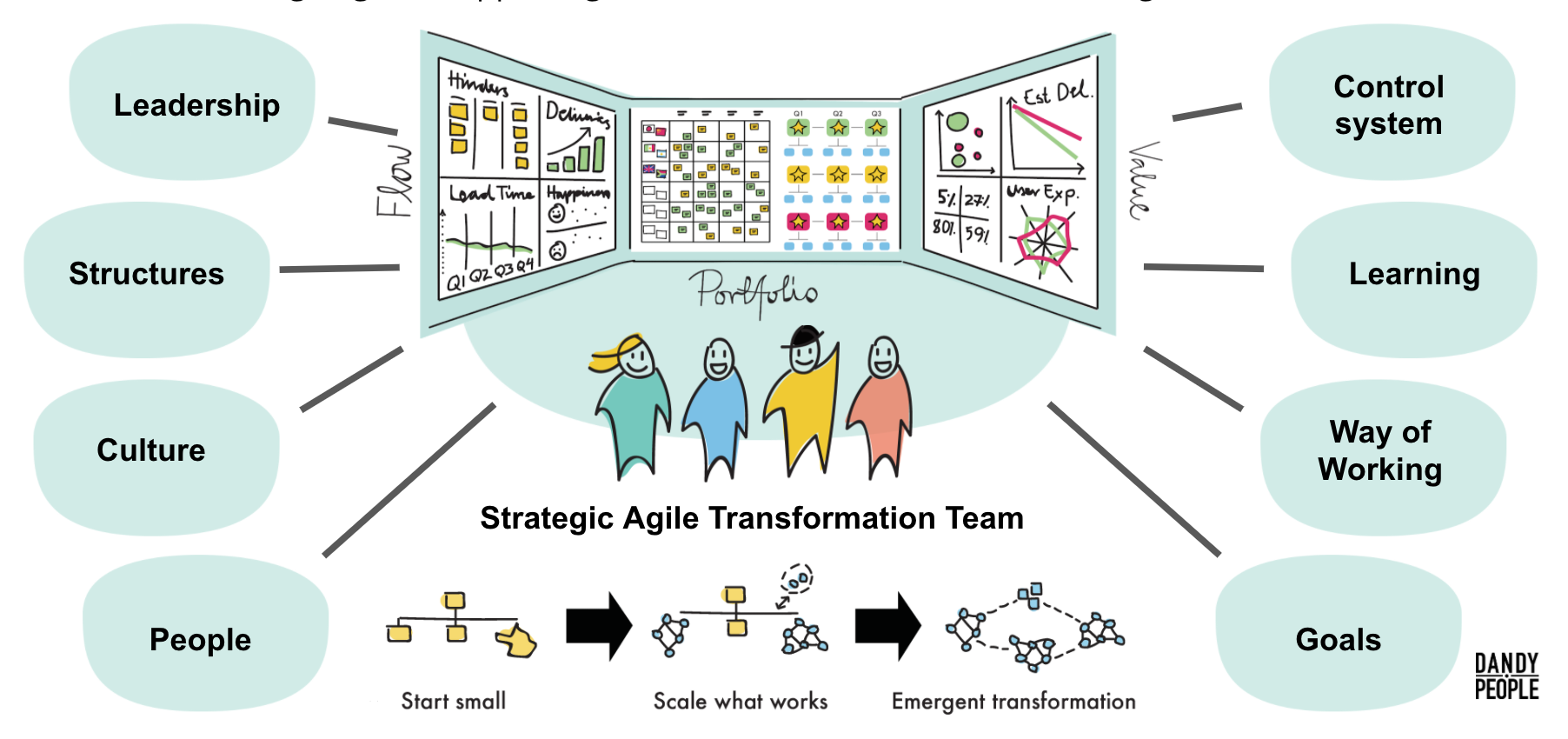Organizations are complex adaptive systems, which means we can not with precision anticipate all possible impacts changing one part of the organization will have on another. And, we cannot anticipate how the organization will evolve in the future and what strategies will emerge. Success, therefore, requires that we make small continuous changes as a natural part of running the business.
Having a clear understanding of how the organization is working from different perspectives is critical when moving from traditional to more Agile structures and ways of working. One way is to look at the organization from different perspectives and they will shed light on what’s holding it back and what can be done to move it forward.
At Dandy People, we have created an organizational analysis model in 9-Dimensions of Organizational Change (TM) that gives a holistic perspective and connects the dots across the organization. This is the best way, we have found so far, to create and sustain a Learning Organization. The model is based on the 6-Boxes Model by Carl Binder.

The culture is created by our behaviors in all other dimensions
This is the reason why culture is placed “outside the circle” in our illustration. However, the external environment is surrounding us and will affect us, which is why it’s represented with arrows flowing in-and-out of the system.
The 9-Dimensional Model of Organizational Change (TM) enables change across the organization that leads to continuous improvement without chaos.
By creating a strategic transformation team, preferably the Executive Leadership Team, that works with the different dimensions, they can support change initiatives in an agile manner.

When using the 9-dimensions model as a shared model across departments and/or value streams we can scale and transform faster than with the traditional top-down management style.

The overall flow of the 9-Dimensional Model of Organizational Change (TM)
Starting up with the analysis

1. Workshops and Interviews
The workshops are a way to facilitate structured conversations to create awareness and a hypothesis of the current and the wanted state in the 9 – dimensions (TM). We then do deep interviews to validate or invalidate the hypothesizes.
2. Analysis
After collecting data within the different domains an analysis is done based on organizational theory, proven experience from agile organizations, and transformations.

3. Strategy
Based on the analysis a transformation strategy is formulated with a high-level roadmap for the change that covers all dimensions.
4. Presentation
Presentations and reflections around the findings are done together with employees as well as the executives. The purpose is to create a common understanding of the situation and boost the change.
The change process is managed in an Agile way of working
The work is structured into sprints, starting with a plan for the sprint and pull items from the backlog. The actual work is done together with people from the organization. Replan is the norm to constantly adapt to the development of the situation.
Measuring improvements continuously
Improvements are measured and visualized on the 9 dimensions portfolio board, looking into metrics of performance and productivity, and health values. The goal of the change is to become a learning organization.
It is crucial that the implementation team becomes high performing. Therefore they need to be treated as any other team and be kept stable over time continuously building new capabilities needed in the team.
Did you like this post? Read more posts on Agile Leadership
>> The 7 Agile Leadership Principles
>> The 7 Conditions for Effective Agile Leadership Teams
>> 5 Common Mistakes when Forming Agile Leadership Teams
>> Starting an Agile Leadership Team
>> How to Form a Team in 10 Minutes
>> The Strategic Leadership Room
>> The FICA-Canvas – Decision-Making as a Team Made Easy
>> How to Manage the System – Not the People
>> Agile Leadership vs Agile Management
>> Learning Organization – What it is and Why it Matters
>> 7 Prerequisites of a Learning Organization
Follow us on LinkedIn for our updates >



